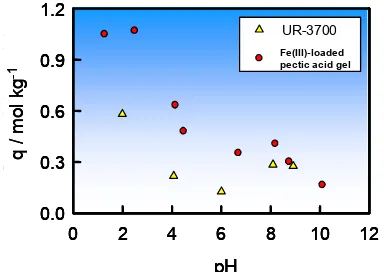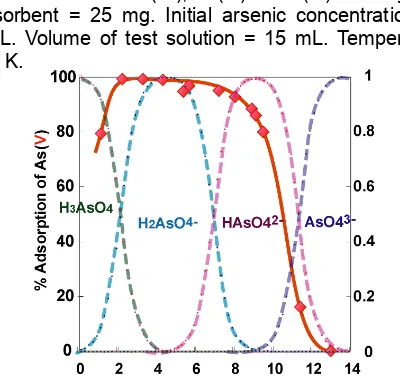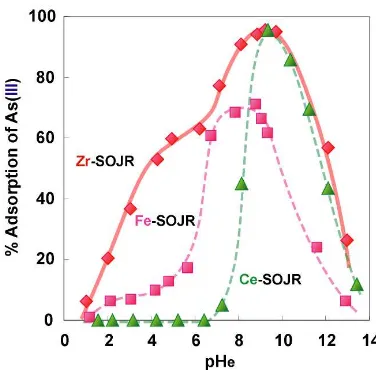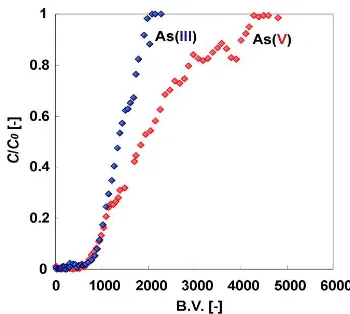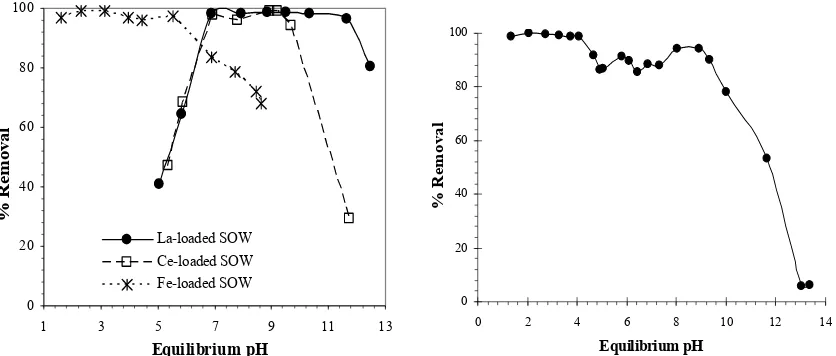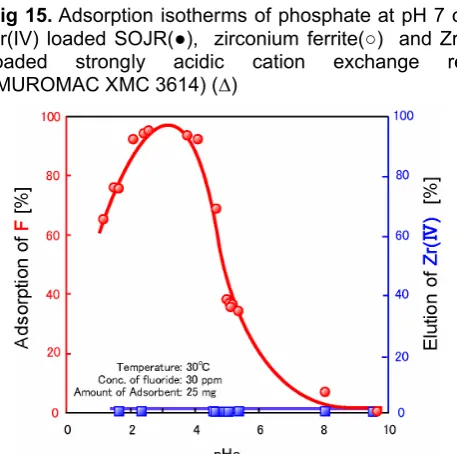* Corresponding author. Tel: +81-952-288671 Email address: inoue@elechem.chem.saga-u.ac.jp
ADSORPTIVE REMOVAL OF HAZARDOUS INORGANIC ELEMENTS FROM WATER BY
USING ORANGE WASTE
Katsutoshi Inoue
Department of Applied Chemistry, Saga University Honjo-machi 1, Saga 840-8502, Japan Received 1 July 2008; Accepted 1 August 2008
ABSTRACT
Pectic acid contained in some fruits like orange and apple is natural chelating polymeric material, exhibiting excellent adsorption behavior for some cationic metal ions including toxic heavy metals such as lead and copper. In addition, it also exhibits excellent adsorption behavior for some hazardous inorganic anionic species like phosphorus, arsenic and fluoride by loading some high valence cationic metal ions like zirconium(IV) in advance.For the practical application to the removal of these hazardous inorganic elements from various waste water at cheap cost, orange juice residue was employed instead of pure pectic acid. Orange juice residue just after juicing was activated by saponification with small amount of calcium hydroxide to prepare the sorbent.Some hazardous cationic species like lead(II), copper(II) and cadmium(II) were effectively adsorbed on this sorbent, while toxic anionic species like phosphate, arsenate, arsenite and fluoride were also effectively adsorbed on zirconium(IV)-loaded sorbent.
Keywords: Orange waste, Pectic acid, Natural chelating material, Heavy metals, Arsenic, Phosphorus, Adsorption, Removal, Water
INTRODUCTION
Huge amount of oranges are harvested on every year in Asian countries. In Japan, majority of oranges are used for producing orange juice. In the production of orange juice, 50 wt.% of orange is converted into orange juice we drink while another 50% is remained as orange juice residue (OJR). At present, OJR is wasted as an industrial waste from juicing factories or used for producing feeds for cattle after drying by using rotary dryers at high temperature. However, it takes high cost for the treatment of waste OJR in Japan, and also the production cost of the feeds for cattle is high, especially the cost for drying is high while its price is very cheap. Consequently, juicing factories in Japan are suffering from the big gap between the high cost and low price, which is paid by consumers of orange juice at present. If OJR were converted into some useful materials at cheap cost, the price of orange juice would be much lowered, resulting in the increase in the consumption and production of orange juice, which bring big profits not only to juicing factories but also to farmers of orange.
OJR contains cellulose, hemicellulose, pectin, lignin as major components and citric acid, sugar, limonene and so on as minor components. Among these, pectin is polysaccharide in which pectic acid, an acidic polysaccharide, is partly methyl esterified. It is easily saponified into pectic acid by some alkaline materials like sodium hydroxide and calcium hydroxide.
In the previous work, [1] we found that pectic acid as well as alginic acid contained in seaweeds are natural chelating polymeric materials, which give rise to stable
5-membered chelates with some cationic metal ions like Pb(II), Cu(II), Fe(III) and so on as shown in Scheme 1.
In the adsorption of cationic divalent metal ions like Cu(II) and Pb(II), they are coordinated with 2 units of pectic acid to give rise to 5-membered chelates releasing 2 hydrogen ions according to cation exchange mechanism. However, in the adsorption of tri- and tetra-valent cationic metal ions like Fe(III), Al(III), lanthanides(III) and Zr(IV), it is inferred to be difficult for all of the positive charges of these metal ions to be fully neutralized only by pectic acid units due to strong steric hindrance; i.e. it is difficult for 3 of 4 pectic acid units to coordinate to one ion of these metals. In the case as such, unsaturated positive charges are neutralized by some anionic species like hydroxide, chloride, bisulphate or bicarbonate existing in water. In addition, the loaded metal ions are coordinated with some water molecules. These anionic coordinating species as well as water molecules are easily and selectively substituted by some hazardous anionic species like phosphate, arsenate, arsenite, fluoride and so on as shown also in Scheme 1. These phenomena had been reported also in the case of metal loaded cation exchange resins in some literatures. [2-4]
O
Adsorption of some oxo anions
such as arsenate (AsO4•jbased on ligand exchange
mechanism
Scheme 1. Adsorption mechanism of cationic metal ions like Pb(II) on pectic acid (right) and oxoanionic metal ions on pectic acid loaded with high-valence metal ions like Fe(III) (left).
Fig 1. Relationship between the amount of adsorbed As(V) on Fe(III) loaded pectic acid gel crosslinked with epichlorohydrin and on commercially available sorbent (UR-3700) for arsenic removal and equilibrium pH.
Scheme 2. Saponification of pectin with calcium hydroxide
than commercially avairable synthetic resin at low pH in particular. This is a good example exemplifying that natural materials some times exhibit more excellent characteristics than artificial materials produced from fossil resources like petroleum.
However, it takes high cost to produce sorbents from pure pectic acid. Instead of pure pectic acid, we hit upon an idea to prepare sorbents from OJR rich in pectic acid at cheap cost for adsorptive removal of some hazardous inorganic elements in water.
Preparation of sorbent from OJR[5]
OJR was treated with calcium hydroxide in order to saponify methyl ester part of pectin contained in OJR to increase the content of the effective functional groups, carboxyl groups, according to the reaction shown in Scheme 2 as described in our previous paper [5] as follows: about 100 g of OJR just after juicing was taken along with 8 g of Ca(OH)2 in a juice mixer and maintained at around 12.5 by adding sodium hydroxide solution. After stirring, the suspension was repeatedly washed with deionized water until neutral pH by means of decantation and finally filtered to obtain a wet gel, which was dried in a convection oven for about 48 hours at 70 ºC to produce the dry gel, which is abbreviated as Ca-type SOJR (saponified orange juice residue), hereafter. The specific surface area of this gel was measured as 7.25 m2/g by using Belsorp 18PLUS (BEL. JAPAN INC.) according to BET method while leading pore size was found to be mesoporous with an average pore diameter of 14.3 nm.
After converting Ca-type SOJR into free acid cheaper sorbent having the same functional groups can be prepared instead of using expensive pure pectic acid.
Adsorption behavior of Ca-type SOJR for some metal ions [5]
Adsorption behavior of Ca-type SOJR was investigated for some cationic metal ions including some toxic heavy metals like Pb(II), Cu(II) and Cd(II). Figure 2 shows the relationship between % adsorption
pHe
0 1 2 3 4 5 6 7 8
%
A
d
so
rp
ti
o
n
0 20 40 60 80 100
Mn(II) Zn(II) Cu(II) Cd(II) Pb(II) Fe(III)
Fig 2. Effect of pH on the adsorption of some metal ions on Ca-type SOJR. Dry weight of Ca-type SOJR = 25 mg. Initial metal concentration = 1 mM. Volume of test solution = 15 mL. Temperature = 303 K
Fig 3. Effect of pH on the adsorption of As(V) on Ca-type SOJR loaded with Zr(IV), Fe(III) or Ce(III) ion. Dry weight of sorbent = 25 mg. Initial arsenic concentration = 20 mg/L. Volume of test solution = 15 mL. Temperature = 303 K.
Fig 4. Relationship between % adsorption of As(V) on Zr(IV)-loaded SOJR as well as distribution of various arsenate species and equilibrium pH.
of metal ions and equilibrium pH where % adsorption is defined as follows:
% adsorption = (Ci– Ce)/Ci x 100
Ci: initial metal concentration, Ce: equilibrium metal
concentration
As seen from this figure, Fe(III), Pb(II) and Cu(II) are strongly adsorbed at such low pH as 1-2 while Cd(II), Zn(II) and Mn(II) are comparatively weakly adsorbed.
From the measurement of adsorption isotherms, it was found that they exhibit the Langmuir type adsorption isotherms and the maximum adsorption capacities were evaluated as 1.55 mol/kg for Fe(III) and as 1.10 mol/kg for Pb(II), Zn(II) and Cd(II), which are high values compared to commercially available chelating resins.
Adsorptive removal of anionic hazardous inorganic elements by metal loaded SOJR
As mentioned earlier, it is well known that some anionic species like phosphate and fluoride can be effectively removed by using cation exchange resins loaded with high valence metal ions with high affinity to these anionic species. However, since these anionic species are cheap, the use of cation exchange resins accompanies too high cost to be employed unless the adsorbed anionic species are effectively eluted and recovered at high concentration and the resins are easily regenerated for reuse for many times. On the other hand, SOJR is much more suitable for this purpose because it is much cheaper than commercially available cation exchange resins and has high enough loading capacities for various high valence metal ions. From the viewpoint as such, we have conducted some research works for the adsorptive removal of As(III and V), P(V) and F using metal loaded Ca-type SOJR.
Adsorptive removal of arsenic[6]
Figure 3 shows the relationship between % removal of As(V) by Ca-type SOJR loaded with Zr(IV), Fe(III) or Ce(III) and equilibrium pH. As seen from this figure, effect of pH is much different depending on the kind of the loaded metal ions, which is considered to be related to the interaction between the loaded metal ions and anionic species of arsenate which depends on pH as shown in Fig 4. For example, in the case of the adsorption on Zr(IV)-loaded SOJR, it appears that H2AsO4
and HAsO4
are selectively adsorbed, the details of which, however, should be elucidated in the future work.
Fig 5. Effect of pH on the adsorption of As(III) on Ca-type SOJR loaded with Zr(IV), Fe(III) or Ce(III) ion. Dry weight of sorbent = 25 mg. Initial arsenic concentration = 20 mg/L. Volume of test solution = 15 mL. Temperature = 303 K.
Fig 6. Relationship between % adsorption of As(III) on Zr(IV)-loaded SOJR as well as distribution of various arsenite species and equilibrium pH.
Fig 7. Leakage of the loaded metal ions from metal loaded SOJR at varying pH.
H OH OH H O
O
Zr+
O C O
OHOH
2 OH
OH
-H2O H3AsO4
H3AsO4
OH
-H2AsO4
-H OH OH H O
O
Zr+
O C O
OH OH2
OH
Anion exchange Anion exchange Ligand
Ligandsubstitutionsubstitution
H2AsO4
-H2AsO4
-H OH OH H
O
Zr+
O C O
OH
OH
OH
-H3AsO4
H3AsO4
H OH OH H O
O
Zr+
O C O
OH OH2
OH
OH
-H2AsO4
-H2AsO4
-H3AsO4
H3AsO4
Alkaline washing Alkaline washing
Scheme 3. Mechanism of adsorption of As(V) on zirconium(IV)-loaded SOJR followed by elution with alkaline solution
Fig 8. Plots of % adsorption of As(V) on Zr(IV) loaded SOJR against equilibrium pH in the absence of foreign anionic species as well as in the presence of excess amount of foreign anionic species. Dry weight of sorbent = 25 mg. Volume of test solution = 15 mL. Temperature = 303 K.
of the loaded metal ions also in the adsorption of As(III), which is considered to be also related to the interaction between the loaded metal ions and anionic species of As(III) which depends on pH as shown in Fig. 6.
It is seen from Figs. 3 and 5 that Zr(IV)-loaded SOJR is much more superior to Fe(III)- or Ce(III)- loaded SOJR as it is effective over wide pH region; effective pH region is pH = 2 – 9 for arsenic(V) and 8 – 11 for arsenic(III). Also from these figures, it is suggested that adsorbed As(III and V) can be effectively eluted at high pH: at pH higher than 13 for As(V) and 14 for As(III).
Figure 7 shows the plot of % leakage of he loaded metal ions from 3 kinds of metal loaded SOJR at varying pH. As seen from this figure, SOJR sorbents loaded with Fe(III) and Ce(III) suffer from the leakage over wide pH region, especially at pH lower than 2. On the other hand, leakage of loaded Zr(IV) is negligible over the whole pH region. From the results mentioned above, it can be concluded that Zr(IV)-loaded SOJR is the most suitable for the removal for both of As(V) and As(III).
Scheme 3 shows the adsorption mechanism of As(V) on Zr(IV)-loaded SOJR as well as elution mechanism with alkaline solution inferred from the experimental results mentioned above. These mechanisms are considered to be the same with the cases of arsenite, phosphate and fluoride which will be described later.
Figures 8 and 9 show the effect of foreign anionic species like sulphate, chloride and carbonate on the adsorption of As(V) and As(III), respectively, on Zr(IV) loaded SOJR. As seen from these figures, the relationship between % adsorption and equilibrium pH is nearly the same whether foreign anionic species exist in excess amounts or not, suggesting that they have no effect on the adsorption of As(V and III).
Fig 10. Schematic diagram of the column experiments.
Fig 11. Breakthrough profiles of As(III and V) from the column. Feed concentration of As (C0) = 4.8 mg/L.
Weight of gel = 0.1 g. Feed rate = 6.5 mL/h for As(V) and 3.3 mL/h for As(III). pH of the feed = 3.3 for As(V) and 9.1 for As(III). B.V. = total volume of the feed which passed through the column until time = t / volume of the packed sorbent.
Fig 12. Elution profiles of As(III and V) from the loaded column after the breakthrough.
0 loaded gel), 60 mg (Fe(III) loaded gel), initial phosphate concentration = 20 mg/L, volume of test solution = 15 mL, shaking time = 24 h, temperature = 303 K.
From the adsorption isotherms of As(V and III) on Zr(IV) loaded SOJR, it was found that both adsorption isotherms exhibit the Langmuir type adsorption and the maximum adsorption capacities of As(V) and As(III) were evaluated as 1.05 and 1.75 mol/kg, respectively, which are much higher than commercially available sorbents.
On the basis of the results of the above-mentioned batchwise adsorption tests, breakthrough followed by elution tests were carried out using the column packed with zirconium(IV) loaded SOJR shown in Fig. 10.
Figure 11 shows the breakthrough profiles of As(V and III) from the column packed with Zr(IV) loaded SOJR under the condition mentioned in the figure legend. It is seen from this figure that the breakthrough takes place at around 600 B.V. for both of As(V) and As(III) while the column is saturated at around 4500 and 2000 B.V. for As(V) and As(III), respectively.
Figure 12 shows the elution profiles of As(V and III) with 0.5 M NaOH solution after the complete adsorption of As. From this figure, it is evident that As(V) and As(III) are eluted from the column enriched as high as 80 and 25 times compared with the feed solution and that more than 90 % of adsorbed As was recovered by this elution; in addition, no leakage of the loaded Zr(IV) was observed during the elution.
Figure 13 shows the result of the cyclic column operation of adsorption of As(V) on Zr(IV) loaded SOJR followed by elution with 0.5 M NaOH until the fifth cycle. Although both of % adsorption and elution are a little bit lowered after the second cycle, they are still higher than 80 %, suggesting the possibility that Zr(IV) loaded SOJR can be used for many times for a long times.
Adsorptive removal of phosphorus[7-8]
Figure 14 shows the effect of equilibrium pH on the removal of phosphate by means of the adsorption on SOJR loaded with 4 kinds of malti-valence metal ions:
Fe(III), La(III), Ce(III) and Zr(IV). Similar to the adsorption of As(V and III), adsorption of phosphate is greatly influenced by the kinds of the loaded metal ions. Nearly quantitative adsorption can be achieved over the pH 1-5 by Fe(III) loaded SOJR and over the pH 7-10 and 7-12 by Ce(III) and La(III) loaded SOJR, respectively. On the other hand, higher than 90 % adsorption can be achieved over more extensive pH region 1-9 by Zr(IV) loaded SOJR.
Figure 15 shows adsorption isotherms of phosphate on Zr(IV) loaded SOJR and zirconium ferrite, commercially available inorganic sorbent for phosphate removal, as well as Zr(IV) loaded MUROMAC XMC 3614 resin, commercially available strongly acidic cation exchange resin, for comparison. As seen from this figure, all of these sorbents exhibit the Langmuir type adsorption. From the constant values in the plateau region, the maximum adsorption capacities were evaluated as 57, 43 and 13 mg/g (1.84, 1.39 and 0.42 mol/kg) for Zr(IV) loaded SOJR, MURONAC XMC 3614 and zirconium ferrite, respectively. That is, the sorbent prepared from biomass waste, natural material, exhibited the highest adsorption capacity.
Similar to the case of the adsorption of As(V and III), adsorption of phosphate on Zr(IV) loaded SOJR was also unaffected by excess concentration of foreign anionic species like sulphate, chloride and carbonate. Also similar to the case of As, phosphate adsorbed on this sorbent was found to be quantitatively eluted with 0.1 M NaOH solution and it was confirmed that the sorbent can be regenerated and reused even after 10 times of the repeat of adsorption followed by elution with 0.1 M NaOH from the cycle test.
0 15 30 45 60
0 150 300 450 600 750 900
Equilibrium concentration (mg/l)
A
m
o
u
n
t
a
d
so
r
b
e
d
(
m
g
/g
)
(a)
57 mg/g
43 mg/g
13 mg/g
Fig 15. Adsorption isotherms of phosphate at pH 7 onto Zr(IV) loaded SOJR(●), zirconium ferrite(○) and Zr(IV) loaded strongly acidic cation exchange resin (MUROMAC XMC 3614) (∆)
Fig 16. Effect of equilibrium pH on the adsorption of fluoride on Zr(IV) loaded SOJR and on the leakage of the loaded Zr(IV).
Fig 17. Adsorption isotherms of fluoride on Zr(IV) loaded SOJR and Amberlite 200CT resin, strongly acidic cation exchange resin, at pH=2.4.
Adsorptive removal of fluoride [9]
the adsorption of As(V and III) and phosphate, the pH region at which nearly quantitative adsorption can be achieved is limited and the maximum adsorption is observed at pH around 3, which is considered to be related to the pKa value of HF (= 2.4). Over the whole pH at which adsorption test was carried out, leakage of the loaded Zr(IV) was not observed.
Figure 17 shows the adsorption isotherms of fluoride on Zr(IV) loaded SOJR and Amberlite 200CT resin, strongly acidic cation exchange resin, at pH=2.4, both of which exhibit the Langmuir type adsorption isotherm. From the constant values in the plateau region, the maximum adsorption capacities were evaluated as 1.2 and 0.5 mol/kg for Zr(IV) loaded SOJR and Amberlite 200CT resin, respectively, from which it was evidenced again that SOJR prepared from biomass waste exhibits more excellent adsorption behavior than artificial ion exchange resin.
CONCLUSION
Various hazardous inorganic elements, not only cationic heavy metals like Pb(II) and Cu(II) but also some anionic hazardous materials like As(V and III), phosphate and fluoride can be effectively removed by means of adsorption using orange waste, which exhibits much more excellent adsorption behavior than commercially available artificial sorbents.
REFERENCES
1. Dhakal, R.P., Ghimire, K.N., Inoue, K., Yano, M., and Makino, K., 2005, Sep. Pur. Technol., 42, 219-225 2. Yoshida, I., Ueno, K., and Kobayashi, H., 1978, Sep.
Pur. Technol., 13, 173-184
3. Takeswhita, R., Yoshida, I., and Ueno, K., 1979, Bull. Chem. Soc. Jpn., 52, 2577-2580
4. Yoshida, I., Konomi, T., Shimonishi, Y., Morise, A., and Ueno, K., 1981, Nippon Kagakukaishi, (3), 379-384 (in Japanese)
5. Dhakal, R.P., Ghimire, K.N., and Inoue, K., 2005, Hydrometallurgy, 79, 182-190
6. Biswas, B.K., Inoue, J., Inoue, K., Ghimire, K.N., Harada, H., Ohto, K., and Kawakita, H., 2008, J.Hazard.Mater., 154, 1066-1074
7. Biswas, B.K., Inoue, K., Ghimire, K.N., Ohta, S., Harada, H., Ohto, K., and Kawakita, H., 2007, J.Colloid Int.Sci., 312, 214-223
8. Biswas, B.K., Ghimire, K.N., Inoue, K., Ohto, K., and Kawakita, H., 2007, J.Ion Exchange, 18, 428-433. 9. Matsueda, M., Inoue, K. Harada, H., Ohto, K.
